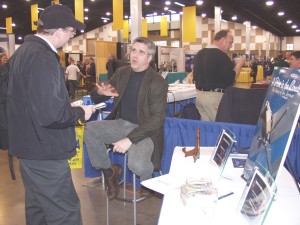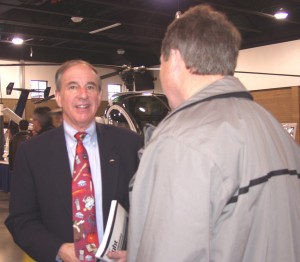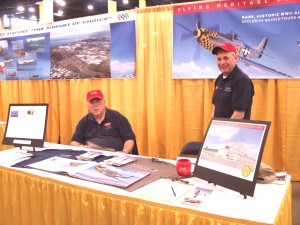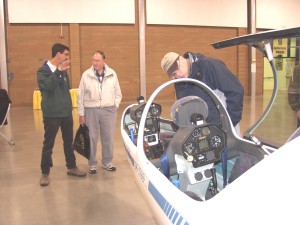
Visitors steadily stopped by to ask Jake Schultz questions about his new book, “A Drive in the Clouds, The Story of the Aerocar.” Publishing it was a culmination of 12 years of research with the inventor, Molt Taylor.
By Terry Stephens
The annual Northwest Aviation Conference and Trade Show, held Feb. 24-25, at the Showplex Exhibition & Conference Center, in Puyallup, Wash., was very successful. According to event coordinator Rachel Hansen, nearly 11,000 people attended the conference, organized by the Washington Aviation Association.
The exhibit hall featured 220 booths. Snohomish County Airport filled four of them, representing the airport, the Future of Flight aviation museum, Everett Community College’s aviation department and Paul Allen’s Flying Heritage Collection of rare warbirds, which will move to Paine Field this summer from its present space at Arlington Airport.
The Olympic Flight Museum in Olympia promoted its historic aircraft displays and the upcoming Olympic Air Show, to be held June 16 and 17. This year’s event will feature the Collings Foundation’s B-24 and B-17, and, for the first time in the Pacific Northwest, the organization’s B-25—all part of this year’s Wings of Freedom tour.
Arlington Airport’s display promoted the airfield’s annual Northwest EAA Fly-In, set for July 11-15. Over the years, this has become the Northwest’s premier aviation event, including daily air shows, guest speakers and dozens of exhibitor booths. Some 50,000 people attend each year, making it the nation’s third largest GA event. After a short absence, the Cascade Warbirds will bring its historic aircraft to this year’s event, and the Flying Heritage Collection will continue its annual display.
Other exhibitors included Airtug, Angel Flight West, Aviation High School, Cirrus Design, Civil Air Patrol, CubCrafters, Embry-Riddle Aeronautical University, FAA’s Northwest region, Whidbey Naval Air Station, Galvin Flying, Kenmore Air Harbor, Microsoft Flight Simulator, Northwest Aviation College, the Pacific Northwest Aviation & Business Journal, Seattle Avionics Software, Spokane International Airport, Wicks Aircraft Supply Co., WSDOT Aviation Division and XN Air. Organizations that exhibited included the Puget Sound Soaring Association, the Aircraft Owners and Pilots Association, the Experimental Aircraft Association, the Washington Pilots Association and Women in Aviation, International.
Speakers

AOPA President Phil Boyer talks with pilots attending the conference. During his keynote speech, Boyer voiced concerns about new FAA funding legislation that could mean user fees and higher fuel taxes for the nation’s general aviation industry.
During his keynote speech, Phil Boyer, AOPA president, told an audience of more than 1,000 that the FAA’s long-dreaded Next Generation Air Transportation System Financing Reform Act of 2007 is finally on paper and ready to begin the long legislative process. Boyer warned that GA will pay much more and airlines will pay less of the cost of operating the nation’s air traffic control system under the FAA’s funding proposal. Boyer said the FAA funding debate simmering in Washington, D.C., has the potential to severely impact GA with higher fuel taxes and new, burdensome user fees for everything from ATC services to medical certificates.
“Under the guise of getting ready for the next generation ATC system, the FAA is recommending an increase of almost four times the present tax on fuel for GA flyers,” he said. “Plus, they want user fees that could be applied for private pilots flying in congested airspace, with the idea that making it more expensive for the GA industry will reduce the number of planes in the air.”
Such user fees are already in place in other countries. According to AOPA research, pilots pay $31 (U.S.) for an ILS approach in Austria, $30 for a weather briefing in the UK and $1,000 for an aviation knowledge exam taken in the Netherlands.
“The airlines want more control of our air traffic,” Boyer said. “They can have more efficiency and productivity within that airspace by keeping GA out of it. Also, the new reform legislation would change funding that is imperative for maintaining GA airports through FAA assistance. We have 410,000 members and many friends in Congress; we intend to fight this legislation. The bill will be debated in the House aviation subcommittee, transportation and infrastructure committee and ways and means committee, and in the Senate aviation subcommittee and science and transportation committee.”
Boyer also spoke about other AOPA projects in the Pacific Northwest. The organization is working to ensure that the U.S. Navy doesn’t impose airspace restrictions around Oak Harbor because of new activities at Whidbey Island Naval Air Station. It’s also involved in the fight to protect Washington facilities such as Swanson Airport (2W3) in Eatonville and Blaine Municipal Airport (4W6) against commercial and residential development proposals. AOPA also is opposing plans to sell or close Tacoma Narrows Airport (TIW) and Bowerman Airport (HQM) in Hoquiam.

Volunteer docents Norm Gordon (left) and John Campbell manned the booth for the Flying Heritage Collection. An artist’s rendition shows the new hangar that’s being converted to display the planes at Paine Field.
Seminars at the conference included several national speakers with a wide range of topics.
Pilot and professional speaker Rod Machado presented “Strategies for Defensive Cockpit Thinking” and “Secrets to Better Piloting Proficiency.” Machado has been flying since 1970 and instructing since 1973, and has more than 8,000 hours of flying time. The certified flight instructor writes a regular column for AOPA’s magazine and is the flight instructor’s voice on Microsoft’s Flight Simulator, beginning with the 2000 version.
Speaking for the AOPA Safety Foundation, Mark Grady covered three topics: “Invitation to Fly,” “Emergency Procedures” and “Decision Making for Pilots.” Grady, a former traffic pilot reporting for three radio stations, is a radio talk-show host and television personality. He warned that poor decision making is the root cause of many aviation accidents.
“Year after year, the National Transportation Safety Board attributes approximately 75 percent of all aircraft accidents to pilot error,” he said.
He suggested that pilots set personal minimums for their flying, such as logging three hours in a specific make and model plane each 90 days; taking a flight review every 12 months; making six instrument approaches every 30 days; always planning a one-hour fuel reserve, both VFR and IFR; and getting 10 hours of rest before a flight.
“Leave yourself an ‘out’ before the flight, in order to avoid external and self-imposed pressure to go,” Grady said. “In the air, actively anticipate the things that could go wrong, maintain an active lookout for things that have gone wrong, and act appropriately and conservatively to remedy each situation. Do the right thing at the right time.”
Veteran pilot Bruce Williams, who worked on six versions of Microsoft Flight Simulator before forming BruceAir LLC in 2004, to develop training materials and multimedia presentations for pilots and flight instructors, talked about using Flight Simulator as a training aid and how to fly a glass cockpit aircraft. A pilot and aviation writer, he remains an active flight instructor for Galvin Flying Services at Seattle’s Boeing Field (BFI), specializing in technically advanced aircraft, simulator instruction, stall and spin recovery training and aerobatics.

William Lynn Weller (left), owner of Northwest Eagle Soaring at Arlington Municipal Airport, talks with a visitor about glider rides and flight instruction.
Boeing 787 technical analyst Jake Schultz presented “A Drive in the Clouds—The Story of the Aerocar,” which is also the title of his new book. For the past 13 years, he gathered material for the book, working with Aerocar designer Molt Taylor and his wife, Neil, to tell their story. Schultz has been featured on Smithsonian Television, National Public Radio and The Discovery Channel.
Rich Stowell has been designated a master certified flight instructor in aerobatics by the National Association of Flight Instructors and is an instructor at CP Aviation Inc. at Santa Paula Airport (SZP) in California. He talked about having a “battle plan” for the inadvertent spin and how to control aircraft during a crisis, coping with control failures and how to survive a crash landing. Designated an “official spin doctor” by the International Aerobatic Club, Stowell has performed more than 27,800 spins with students. He has also scripted several aviation videos, including the FAA’s “Loss of Control” series, and conducts safety seminars nationally, as well as in Canada, Japan and Indonesia.
Lori MacNichol, who owns and operates McCall Mountain/Canyon Flying Seminars, a flight school in McCall, Idaho, related her insights about backcountry flying at mountain airstrips. She conducts aviation seminars for GA pilots and groups including government agencies, such as the U.S. Border Patrol and U.S. Forest Service.
Gene Hahn, vice president of flight operations for Horizon Air, presented “The Airlines Are Hiring,” talking about the current market for airline pilots. He focused particularly on smaller airlines, such as Horizon Air. A pilot for more than 30 years, he oversees more than 500 daily flights for the airline, with its fleet of 70 CRJ-700, DHC-8-400 and DHC-0-200 aircraft.
Awards
At the Saturday evening banquet, the Washington Aviation Association presented three 2007 Aviation Hall of Fame awards for outstanding lifelong contributions to improving aviation in the Pacific Northwest. The recipients were F.E. “Mac” MacSpadden, Scott Gardiner and W. Ken McCoy.
F.E. “Mac” MacSpadden is the former state air search and rescue coordinator for the Department of Transportation’s Aviation Division. Beginning with the Civil Air Patrol in the 1970s, he served as a mission pilot and manager. He later returned from retirement to serve as the state’s SAR (do you mean search and rescue?) coordinator. A B-17 pilot during World War II, he was an accomplished mountain flying pilot and instructor. The effective grid-searching pattern he developed now bears his name. Both he and his wife, Chris, were instrumental in the success of the Wenatchee Mountain Flying clinic, where, together, they trained thousands of pilots.
Scott Gardiner retired after 30 years with the FAA’s Seattle Flight Standards District Office. He was first fascinated with aviation at age 10, when he saw a friend with a flying model powered by an .049 engine. After graduating from college, he took flying lessons that marked the beginning of a 40-year career in aviation. As a fulltime flight instructor he obtained 7,000 flight hours. One of his most memorable accomplishments was partnering with aviation consultant Chuck Gross and Bill Hamilton of the Washington DOT’s Aviation Division to create the Northwest Aviation Conference.
W. Ken McCoy has been associated with aviation in the Northwest for 60 years. After enlisting in the U.S. Air Force in 1949, he was assigned to electronics school. Soon after arriving at Rapid City Air Force Base in South Dakota, however, he was transferred to flight duty as an electronic countermeasures observer. For 10 years, he flew as part of a B-36 bomber crew. During those years, he earned his private pilot’s license, then his instrument, commercial, multi-engine and instructor ratings. Long active in military flying clubs as a flight instructor until his retirement, McCoy then became an FAA designated pilot examiner, a position he held for more than 20 years. Asked to work for DHL in 1987 to help create a global airfreight business, he was the company’s original director of flight operations until leaving in 1995. He continued flying as a DPE and conducted flight instructor refresher clinics for both the Washington and Oregon aviation departments. Even after having quadruple bypass heart surgery, he managed the Washington Aviation Association’s Anti-Drug and Alcohol Consortium until 2006.












